You guys rock! I've been coming here for weeks identifying the birds in our backyard for my daughter's school project. Thanks so much for this valuable resource.
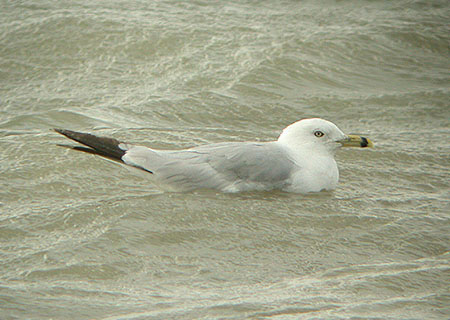
Adults are 49cm length and with a 124cm wingspan. They have a white head, neck and underparts and a relatively short, yellow bill with a dark ring. The back and wings are silver grey and they have yellow legs. Their eyes are yellow. This bird takes three years to reach its breeding plumage; its appearance changes with each fall molt.
Their breeding habitat is near lakes, rivers or the coast in Canada and the northern United States. They nest in colonies, often on islands; the nest is on the ground near water. This bird tends to be faithful to its nesting site, if not its mate, from year to year.
They are migratory and most move south to the Gulf of Mexico and the Atlantic and Pacific coasts of North America, also the Great Lakes.
This gull is a regular wanderer to western Europe, and in Ireland and Great Britain it is no longer classed as a rarity, with several birds regularly wintering in these countries.
These birds forage in flight or pick up objects while swimming, walking or wading. They also steal food from other birds and frequently scavenge. They are omnivorous; their diet may include insects, fish, grain, eggs, earthworms and rodents. These birds are opportunistic and have adapted well to taking food discarded or even left unattended by people.
Photo © Steve Arlow
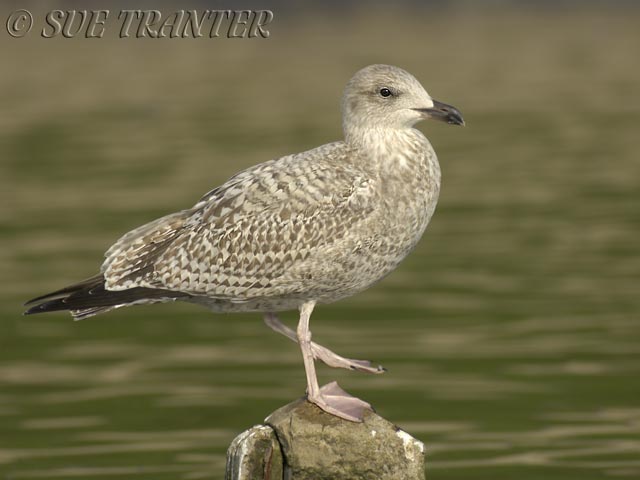
adult pictured above and juvenile below
The Herring Gull, Larus argentatus, is a large gull which breeds across North America, Europe and Asia. It migrates further south in winter. Some are permanent residents on the lower Great Lakes and the east coast of North America. Herring Gulls are also abundant around inland garbage dumps, and some have even adapted to life in inland cities.
The taxonomy of the Herring Gull / Lesser Black-backed Gull complex is very complicated, different authorities recognising between two and eight species.
This group has a ring distribution around the northern hemisphere. Differences between adjacent forms in this ring are fairly small, but by the time the circuit is completed, the end members, Herring Gull and Lesser Black-backed Gull, are clearly different species.
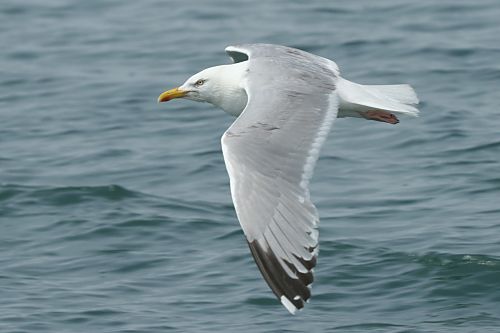
Adult Herring Gulls are similar to Ring-billed Gulls but are much larger, have pinkish legs, and a much thicker yellow bill with more pronounced gonys. First-winter Herring Gulls are much browner, but second and third-winter birds can be confusing since soft part colors are variable and third-year Herring Gull often show a ring around the bill. Such birds are most easily distinguished by the larger size and larger bill of Herring Gull.
Photo © Adrian Webb
Photo © Sue Tranter
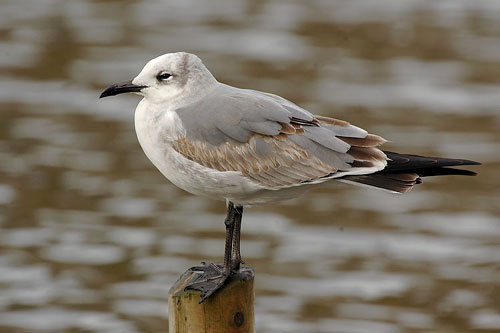
makes laughing call. In winter and juvenile has no black hood. Top picture adult summer, below is juvenile.
The Laughing Gull, Larus atricilla, is a medium-sized gull of North and South America. It breeds on the Atlantic coast of North America, the Caribbean, southern California, USA, and northern South America. Northernmost populations migrate further south in winter, and this species occurs as a rare vagrant to western Europe, although there was a large influx into North-west Europe in late October 2005 when there was a minimum of 18 (and anywhere up to a possibly maximum of 35) individuals on one day in the UK alone. The Laughing Gull's English name is derived from its raucous kee-agh call.
This species is easy to identify. It is 36-41 cm long with a 98-110 cm wingspan. The summer adult's body is white apart from the dark grey back and wings and black head. Its wings are much darker grey than all other gulls of similar size except the smaller Franklin's Gull, and they have black tips without the white crescent shown by Franklin's. The bill is long and red. The black hood is mostly lost in winter.
Laughing Gulls take three years to reach adult plumage. Immature birds are always darker than most similar sized gulls other than Franklin's. First year birds are greyer below and have paler heads than first year Franklin's, and second years can be distinguished on the wing pattern and structure.
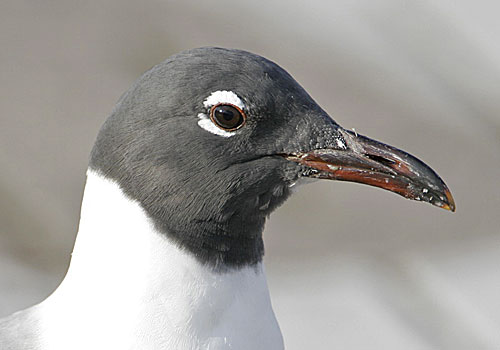
Laughing Gulls breed in coastal marshes and ponds as far north in large colonies. The large nest, made largely from grasses, is constructed on the ground. The 3 or 4 greenish eggs are incubated for about three weeks. These are omnivores like most Larus gulls, and they will scavenge as well as seeking suitable small prey.
Photo © Steve Valentine
Photo © Marc Read
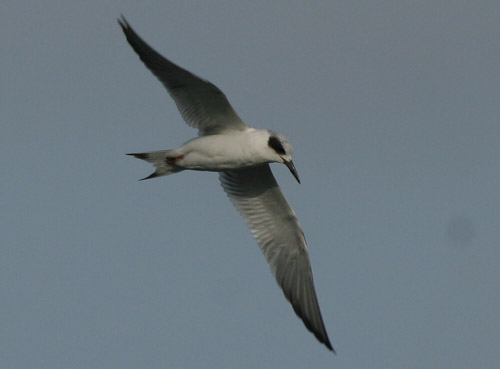
winter plumage pictured. In summer has black cap and reddish beak.
The Forster's Tern feeds by plunge-diving for fish, but will also hawk for insects in its breeding marshes. It usually feeds from saline environments in winter, like most Sterna terns. It usually dives directly, and not from the "stepped-hover" favoured by the Arctic Tern. The offering of fish by the male to the female is part of the courtship display.
This is a small tern, 33-36cm long with a 64-70cm wingspan. It is most similar to the Common Tern. It has pale grey upperparts and white underparts. Its legs are red and its bill is red, tipped with black. In winter, the forehead becomes white and a characteristic black eyemask remains. Juvenile Forster's Terns are similar to the winter adult. The call is a harsh noise like a Black-headed Gull.
This species is unlikely to be confused with the Common Tern in winter because of the black eyemask, but is much more similar in breeding plumage. Forster's has a grey centre to its white tail, and the upperwings are pure white, without the darker primary wedge of Common.
Photo © Sean Cronin